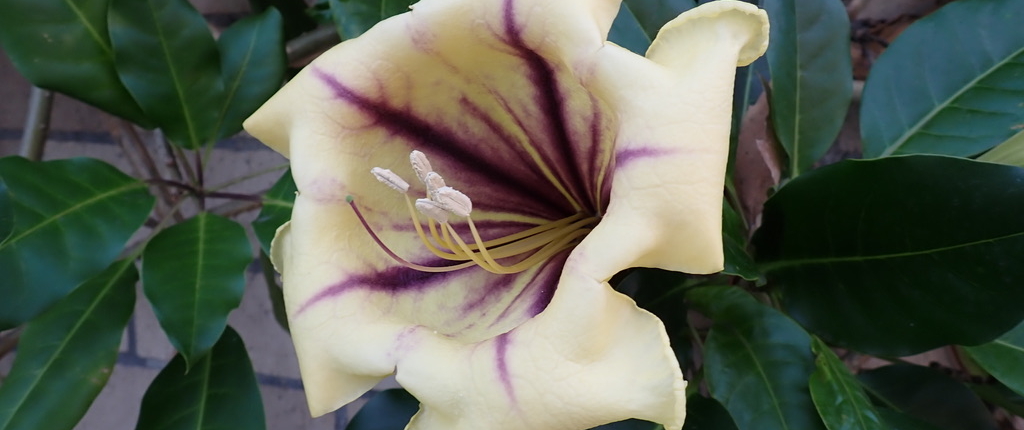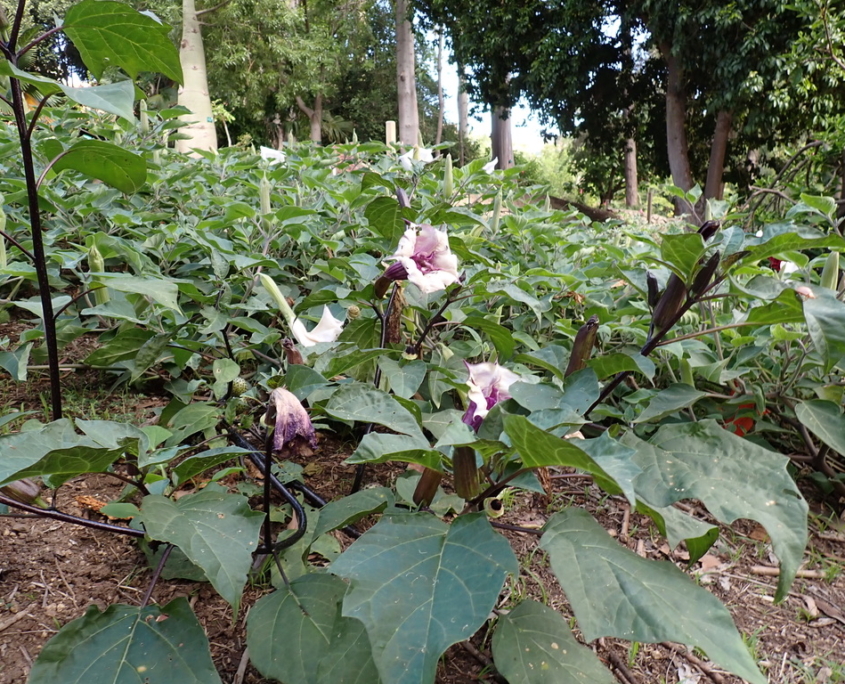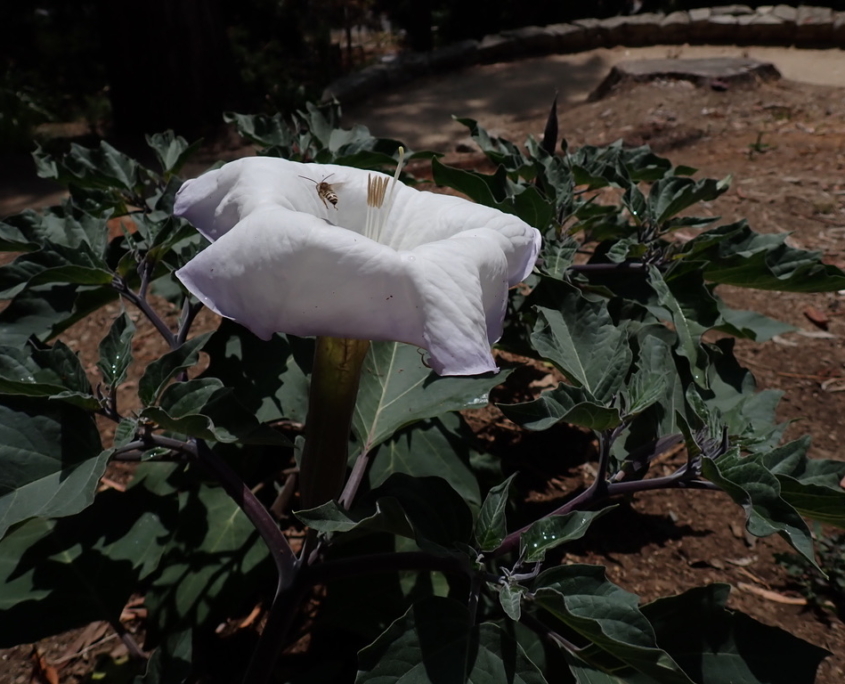DISCOVER THE HERBARIUM’S INITIATIVES COLLABORATIONS CURRENT PROJECTS
HEALING & HARMING GARDEN
The Healing & Harming Garden is a physical and conceptual space imagined by Vikram Tamboli and nurtured in collaboration with Anthony Baniaga. It forms a core project of the Plants and Peoples initiative of the UCLA Mathias Botanical Garden. Showcasing plants that have been linked to healing and harming traditions around the globe, the Garden facilitates a campus wide conversation about the multiple ways of conceiving, living, and honoring the natural world. The Garden is transdisciplinary. It brings together specific conversations emerging from the disciplines of History, Geography, Medicine, and Ecology and Evolutionary Biology, and centers multiple ways of engaging the power and sacred intelligence of plants and promotes the core principles of Environmental Humanities Education. The Garden privileges ‘Native,’ ‘Indigenous,’ and/or ‘Alternate’ epistemologies and cosmologies from across the world (American, African, Asia, and European) to provoke a dialogue with Enlightenment Science and its specific genealogies of knowledge and its traditions of bioprospection, classification, curation, and archival preservation. As a physical space within UCLA’s Botanical Garden, The Healing & Harming Garden project provides a new way of conceptualizing the role of the garden as teaching tool and proposes a means of reading plants, the landscape, and, more generally, the natural world, as a part of a cross-cultural lexicon of power and knowledge.
Phase I: The Otherworldly and the Ornamental
The first phase of the garden project is underway and showcases a world of manit, momoy, tamet mih’a, toè, toalache, toalitzin, sacred datura, floripondio, moon flower, jimsonweed, morning glory, chalice vines, devil’s and angel’s trumpets. As spiritual awakeners and shamanic assistants, as pain relievers, aphrodisiacs, and poisons, these healing and harming plants are lumped together in the Linnaean family of Solanaceous plants and are cultivated widely across the Americas, Asia, Africa, and Europe. Over the course of Fall 2022 and Spring 2023 Vikram and Anthony planted Daturas, Brugmansias, and Solandras to begin a discussion about the way we think about the relationship between aesthetics and spirituality that bind the Atlantic and Pacific Worlds to the continental Americas. In addition to being beautiful and powerful spiritual beings, these plant bodies are also toxic to humans and connected to the history of healing and harming as medicines and as vectors of resistance, control, deception, and manipulation.
Not unlike another well recognized member of the Solanecous family member—Tobacco—Datura, Brugmansia, and Solandra varieties force us to consider the relationship between the ornamental and the otherworldly. A key source of atropine in the historical development of Western Medicine, in Mexico varieties of Datura and Solandra are rumored to be used by women to control wayward spouses as much as they form parts of sacred landscapes, pathways to shamanic discovery, and, sometimes, death. Burundanga in Colombia is the popular name for the chemical compound escopolamina derived from floripondio or Brugmansia arborea and it is often used to drug, confuse, rob, and/or otherwise take advantage of people. In the adjacent Andean highlands of Peru as well as in parts of the Brazilian Amazon, it is a recognized shamanic technology. Escopolamina or scopolamine was also a drug developed by the United States military for mind control experiments and this application of Indigenous knowledge denaturalizes the relationship between ancestral knowledge of the fine line between healing and harming and the operation of State power. In homologous fashion, across India Datura metel is widely offered to Lord Shiva, the creator and destroyer of the universe and a supreme deity in the Hindu pantheon. Steeped in rumor is the related history of Thugees. As groups of allegedly anticolonial criminals who came to prominence during the nineteenth century, they were also famously devotees of Shiva and Kali Mata, his consort, the Great Mother and a manifestation of ultimate cosmic power and death. Thugees, it was alleged by colonial officials, used Datura metel to poison and rob elite travelers in the forested interiors of the British Raj. Today Tantric hindu ritual worship of Kali sometimes still involve the consumption of Datura. In the Healing & Harming Garden, Daturas, Brugmansias, and Solandras initiate a conversation about the porous and shifting boundaries between the magical, political, poisonous, therapeutic, and aesthetic.
Development of Phase 1:
Between December 5 and 6, 2022, Anthony and Vikram sourced and planted Sacred Datura (Datura wrightii) from Evan Meyer at the Theodore Payne Foundation. The decision was to honor the Indigenous groups of Southern California and their long spiritual relationship with this vegetal being. Anthony also took cuttings of Solandra (maxima) from outside UCLA’s medical school and sourced seeds of a tropical variety of “Double Whorl” Datura (Datura metel ), common in India. Although troubled by heavy rains, the Sacred Datura survived the California winter in The Healing & Harming Garden.
By May 2023 the Sacred Datura showed signs of modest growth and robust root structures. The “Double Whorl” seeds had also sprouted and were quickly placed by their sacred sisters. With the support from Sean Lahmeyer and Dylan Hannon, Vikram also arranged for additional cuttings of “Brazilian Gold” (Solandra maxima) and different Brugmansia candida varieties, namely “Betty Marshal,” “Double White”, and “Double Whorl,” to be taken from the The Huntington Library and Gardens. Dylan also provided a rare cutting of Methysticodendron amnesianum known originally as ‘Mutscuai borrachera’ by creators of the cultivar, the Kamëntsá people of Colombia. Mutscuai means ‘snake’ in Kamsá and ‘borrachera’ is the Spanish word for intoxicant or intoxicating.
During a conference and research trip to Mexico in June 2023, Vikram took the opportunity to further develop his knowledge of the world of Solanaceous plants, to meet the ethnobotanist Robert Bye and learn more about the Huichol and other peoples use of Solandra and Datura. The trip helped further develop a Healing & Harming bibliography for the further study of Datura, Solandra and Brugmansia. In line with the educational outreach mission of the project, that same summer Anthony and the UCLA Herbarium provided paid summer internships for high school students from the Anawakalmekak Indigenous Peoples School to investigate ethnobotanical knowledge and the stories that bind plants and peoples together. By October 2023, cuttings taken from the Huntington Library and Garden and carefully propagated and cared for by the Nursery staff there, had rooted. Vikram transported them to the UCLA Botanical Garden’s outdoor growing shed for transplantation in the Spring 2024.
Between Fall 2023 and Winter 2024, The UCLA Mathias Botanical Garden underwent major renovations and restructuring of its stream feature. The resulting work slowed progress in developing the The Healing & Harming Garden plot, as heavy machinery and work crews bustled about. The planting planned for Spring 2024, as a result was delayed, and unfortunately, because of poor outdoor conditions for Brugmansias in the outdoor growing shed, most of the cuttings from the Huntington perished with the exception of a few Betty Marshal cultivars and, surprisingly, the Mutscuai borachera! Moreover, on November 14, 2024, The Huntington Library and Garden invited Vikram to deliver the first public lecture on “Datura: Otherworldly and Ornamental” in which he promoted the conceptual framework for the garden and mapped the elusive and entangled global history of Datura. Between November 2024 and May 2025, Anthony not only rescued and relocated a Brugmansia that was threatened by construction in another section of the larger Botanical garden, but also moved a hibiscus that was crowding The Healing & Harming Garden. By May 2025, Anthony had also planted three Solandra, two Brugmansia ‘Betty Marshal’ cultivars, and the Mutscuai borachera. The Garden project currently awaits a trellis for the Solandra vines, a task which Vikram and Anthony hope to complete between Fall 2025 and Spring 2026. In 2026, The Healing & Harming Garden project also expects to host a public conference to give UCLA faculty an opportunity to dialogue with experts on the relationship between plants and peoples from in the Americas and beyond.





